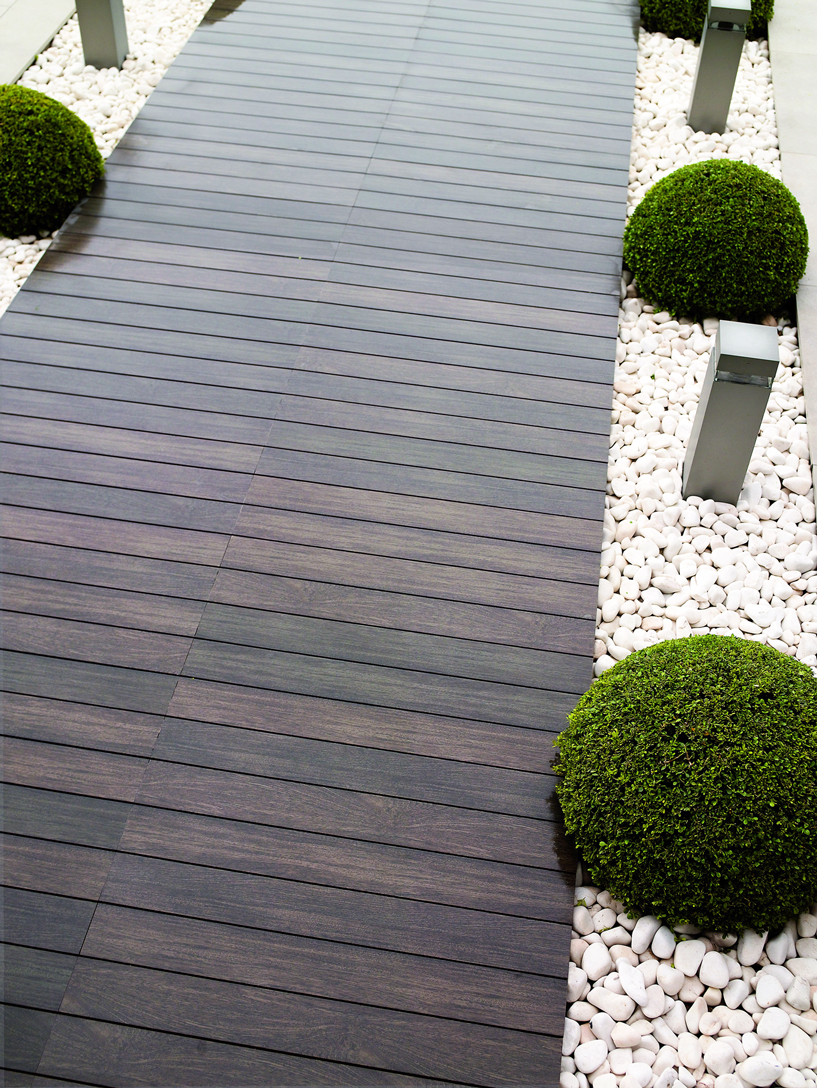
Looks like timber!
Jim Fogarty says there’s more than one way to bring the great look of timber into your garden design, and some of the easiest-care options don’t use any real timber at all.
Lots of people would agree that it’s hard to beat the look and feel of natural timber, but there are certain situations where a substitute product has its advantages. Added to this are the ethical choices when it comes to selecting timber for a garden project. There is a growing market for timber substitutes in the landscape and each has its own merits. However, timber alternatives don’t necessarily equate to environmental solutions and you need to make informed choices when looking at the various product options.
The alternatives
Timber substitutes include concrete, GRC (glassfibre reinforced concrete), and composite products that are generally manufactured using recycled plastics combined with wood ships or sawdust.
There are various reasons for using alternatives. In fire-prone areas, concrete substitutes for timber are safer for obvious reasons. In termite-prone areas, timber substitutes are a good option. Other reasons include reduced maintenance in that decks and screens don’t require staining or oiling. Some products are also mouldable, making them ideal for custom-making unusual shapes such as pots and furniture.
Concrete products
Concrete can be used successfully as a timber alternative and this makes sense in fire prone areas or places where rot and termites can be problematic. Real-Crete is a concrete railway sleeper timber substitute that can be used for fences and retaining walls. Concrete sleepers can also be used to form up raised vegetable beds. Concrete is long lasting and will not break down and rot like timber, making it a good consideration as a timber alternative.
Fibre-cement
This is often called GRFC – Glass Reinforced Fibre Cement. Quatro Design manufactures a range of landscape products using glass-fibre reinforced concrete. The glass-fibre strands in the mortar increase strength while reducing weight because of the much thinner wall sections. This lightweight feature of GRC also makes it safer and easier to handle on-site, and reduces loads on structures when installed. The flexibility of the manufacturing process allows for custom designs and is great for furniture, bowls, planters, water features, wall panels and even modular wall systems.
Composites
Composite products are generally manufactured using recycled plastics combined with woodchips or sawdust. It is important to ensure the woodchips come from ethical sources. Benefits of composite products are that they are resistant to rot and termites, they don’t splinter, and you won’t get any tannins leaching and causing stain problems on paving. Manufacturers claim boards wont warp or cup, although there have been problems with hollow boards in the past. Products are now sold as solid boards and tend to be more stable as long as installation is carried out correctly. Timber decking alternatives have the flexibility of being used for screens, furniture and cladding.
Sources: Future Wood manufactures deck, screen and cladding products made from a combination of recycled industrial waste, post consumer waste, sawdust and discarded rice husks. BriteDeck is made from recycled wood fibres and polymers and comes in three standard colours. Modwood is made from recycled wood and plastic and comes in four colours.
Plastic composites
Multipanel is manufactured from a high-density polyurethane composite material that will not rot and is ideal for fencing, raised garden beds, cladding, water features and outdoor furniture.
Steel alternatives
Steel is another alternative for timber and can be rolled to form unusual and curvaceous shapes. Steel comes in many forms with galvanised and stainless options being resistant to rust. As well as standard steel suppliers, there are companies such as Smart Slat that manufacture a ready-to-use, two-part steel slat and louvre system that is ideal for fencing, screens, gates and cladding.
Aluminium
DecoWood manufactures a timber-looking aluminium product that can be used for window and door frames, fences, screens, shutters and balustrading. A subsidery product, DecoDeck, is a timber looking aluminium decking that maintains its strength, durability and vibrancy, without any staining or oiling required. DecoDeck is an aluminium decking profile that replicates the form of a timber deck. The plank is coated in the DecoWood woodgrain powder-coating, a marine-grade finish more durable than standard powder-coating.
Ceramic
A new-look ceramic tile has been developed in Spain to give the look of timber without the maintenance or need to cut down trees. Porcelanosa’s Parker ceramic tile comes in a timber board configuration that looks like strips of timber. As they are a fully vitrified porcelain the tiles are extremely durable and completely resistant to chlorine and salt, as well as being UV-resistant (so they will not fade or discolour) and fully fire-retardant. The exterior version is non-slip and is perfect for pool surrounds and can be brought right up to the pool edge. It is now sold in Australia by Earp Brothers (see contacts below).
Contacts
realcrete.com.au
quatrodesign.com.au
futurewood.com.au
britedecking.com.au
modwood.com.au
multipanel.com.au
smartslat.com.au
deco.net.au
decodeck.com.au
earp.com.au


